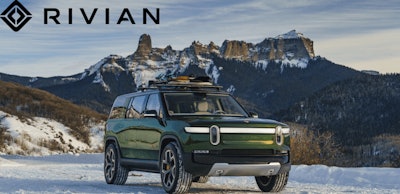
Plymouth, Michigan — New OEM and EV startup, Rivian, intends to create a network of certified collision centres to fix its electric truck and SUV reaching consumers in summer 2021.
The startup electric vehicle manufacturer has begun soliciting interest from autobody shops through an online form and at certifiedcollisionnetwork@rivian.com.
The network is expected to be composed entirely of independent shops, Rivian collision repair program senior manager Kelly Logan confirmed Monday.
“We’re looking for great shops,” Logan said.
Rivian will establish its own network of mechanical service and repair facilities but rely on “third-part collision centres,” he said.
For collision centres, it’s a chance to get in on the ground floor of what’s likely to be the first completely electric pickup to reach consumers. The new OEM plans to begin deliveries of the R1T electric truck in June 2021 and its electric R1S SUV in August 2021.
As well, Rivian plans to create an electric van fleet for Amazon expected to hit the streets in 2022, and it intends to set up a separate certified collision network for that commercial fleet work.
The certified shops will enjoy a captive audience. Logan said that Rivian plans to restrict structural and high-voltage equipment parts, selling them only to the network facilities.
Structural components would include anything “bonded, riveted or welded,” to the vehicle, said Logan. He described the restricted high voltage components as anything which would need special repairer training, calling it a safety issue.
When asked about the materials shops could expect on the truck, Logan explained that he could only confirm it was a “mixed-material” vehicle.
Rivian collision repair program manager Frank Phillips said that “out of the gate,” all network shops would be qualified for structural repairs. But that “nothing’s off the table,” for the program in the future.
Logan said Rivian plans to have service centres in the major markets, with similar facilities in smaller markets. But as for the collision program, he said his experience indicated it was better to have body shops in “as many places as you can.”
Logan spent more than four years building and managing Tesla’s autobody repair network before leaving the company in 2016.
“There’s always a need,” Logan said and encourages all shops to apply.
Phillips said the company was evaluating the shops expressing interest and aggregating data. They will start contacting repairs with the formal application process early next year, with some of its first network shops moving through the onboarding and application process by the end of the first quarter, he said.
Many more OEM certification programs and advanced vehicles exist now than when Logan was helping develop a body network for Tesla in 2012.
Logan said Rivian was examining what its vehicle needed for repairs—the company is simultaneously hustling to develop OEM repair procedures—but would “whenever possible,” institute shop requirements that matched other OEM programs.
Logan notes that the 2015 aluminum F-150 made operations like self-piercing riveting and tools like pulsed-MIG and silicon bronze welders more mainstream.
“The industry has changed a lot,” he said.
Rivian will publish its standard and tool list next year, but Logan is “pretty confident” equipment from other OEM programs that would meet its requirements.
The company plans to work with I-CAR on training but also institute its own internal training for certified shops as well, explained Logan, who calls it a “two-stop approach.”
He noted that the impending launch of the vehicle meant Rivian was inevitably “going to have onsite training,” on early wrecks.
Rivian plans to offer estimation specialists who can educate repairers on that process and work with Audatex, CCC, and Mitchell on issues with their system. Logan says the company will have an R&D collision workshop for technicians to research researching flat-rate labour times.
Logan believes the company could work with the information providers at first, but “will validate all the time.”
As far as welding testing—some OEMs adopt I-CAR’s standards; others require an in-house test, which Logan is “still determining.” He’s also introduced further quality checks, such as unannounced visits.
Right now, the company faces the challenge of launching a completely new model in seven months. As Phillips observed, the various variables discussed were all the “ingredients,” of a certification program, which the company hadn’t yet reached the point of mixing the batter.
“It’s all coming,” said Philips.























